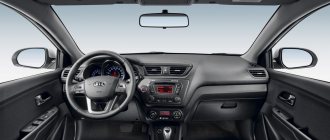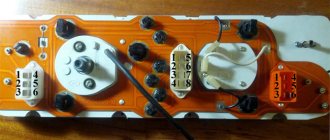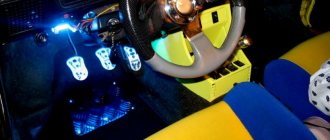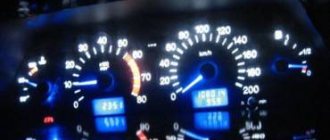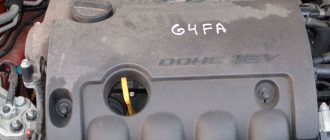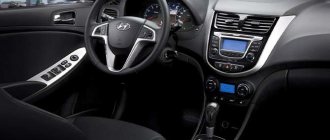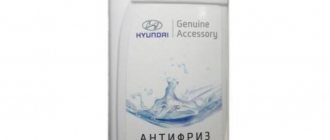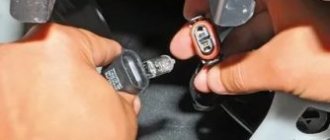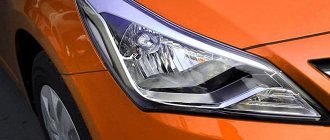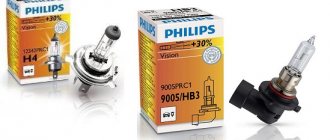Possible malfunctions of the device and methods for eliminating them
This is a complex, reliable complex, characterized by unpretentiousness and rare breakdowns. However, problems happen here too. The main malfunctions are as follows.
- Broken or damaged arrow indicators. Eliminated by replacing the module or pointer drives.
- Indicator lamp burns out. The indicator on the instrument panel stops lighting. The problem is resolved by replacing the light bulb.
- Failure of relays, fuses. Can be repaired by standard workshop repairs.
- Short circuit of contact pins and connectors. A breakdown can lead to a complete replacement of the device. Resoldering leads reaches 50% of the cost of a new part.
Lighting system indicators
In this category we have collected the main symbols on the dashboard related to the car lighting system. Most of these indicators are probably familiar to you, but there are also some that you will see for the first time.
This green sign lights up when the vehicle's side lights are turned on.
In turn, this icon on the panel notifies that the low beam headlights are on and there are no problems.
These LEDs, or variations thereof, indicate a problem, possibly a broken headlight. Most often, the cause is a burnt-out lamp or any other problem in the lighting system.
The displayed blue symbol is located in the center of the instrument panel and lights up when the headlights are on high beam. This is the only blue indicator on the dashboard, which, when turned on, very often blinds the driver at night.
The presence of this symbol on the panel indicates that the car is equipped with an automatic high beam control system. When activating the mode, you do not need to constantly switch from high beam to low beam, since the automation does it for you.
These symbols indicate a malfunction of the automatic headlight leveling function. This is standard on xenon headlights, but is also found on some halogen headlights. In addition, this indicator may not appear at all, even if the car is equipped with this system.
When these symbols illuminate, the Adaptive Headlights system is disabled or inoperative and requires service. When faults are detected, the LED may also begin to flash. But don't worry too much about it, even if this indicator is on, the headlights will work fine.
These symbols light up when the daytime running low beam system is activated. They are quite rare in cars.
This yellow sign, when illuminated, indicates a probable fault with the lamp in the rear headlights. As a rule, replacing a non-working light bulb is more than enough to solve the problem.
The icon lights up when the front fog lights are turned on. As a rule, it is located on the button itself; if you need to turn on the headlights, you just press it.
When only the rear fog lights are turned on, a similar orange symbol lights up. Although an orange light indicates a problem, this is not the case in this case. The fact is that drivers behind you can be blinded if they are used inappropriately when they are not needed. Improper use of fog lights may cause difficulties for others, this indicator is orange.
The arrow flashes when you signal a change in direction. Depending on the position of the switch lever on the dashboard, the first or second arrow lights up. If two arrows flash at once, this means that the alarm is on.
Information displays on the dashboard for technical messages and warnings.
Car dashboard: description, tuning, repair
In the operation of the control panel, malfunctions may appear over time:
- Failure of the device itself. If the shield breaks, there can be many signs of this. For example, all devices and instruments will refuse to work, or maybe only some of them. The car owner will have to check the unit for faults and repair it. Moreover, it is better to contact specialists for repairs, especially if you have never performed a similar task before. Moreover, it will not be possible to properly check the unit without the appropriate equipment.
- The backlight of the device has disappeared, but all equipment is working normally. If this is the case, then the reason is unlikely to lie in burnt-out light bulbs; most likely, it needs to be looked for in the fuses or cable. After all, it may be damaged - this can be diagnosed using a tester. If it turns out that the problem is with the cable, it needs to be changed.
- All or some of the indicator lights do not work. The problem can be caused either by a malfunction of the microcircuit itself, or by a burnt-out light bulb or a breakdown of one or another sensor. If the sensor fails, the lamp may remain on continuously. Burnt-out light bulbs should be replaced, and if you notice that there are oxidized contacts on the circuit, they need to be cleaned. Sometimes the reason lies in the contacts of the lamp socket being too loosely attached to the board; if this is the case, then the contacts just need to be bent.
- The speedometer refuses to work. In most cases, the reason lies precisely in the board itself, so it will be necessary to fully diagnose it before drawing any conclusions.
- The fuel level or coolant temperature controller refuses to work, or these devices work but show incorrect data. First of all, you need to check the sensors - sometimes they fail, sometimes the wiring breaks, and in some cases the reason, again, lies in acidified contacts. If the regulator breaks down, the device must be replaced with a new one, if the wiring is broken, the wire must be changed, and if the contacts are oxidized, the terminals must simply be cleaned (the author of the video is Sergey Zhuravlev).
The need to remove the instrument panel can be caused by a variety of reasons.
The panel on the Hyundai Solaris does not work well or has completely failed. As a rule, in such a situation, some of the indicators cease to function. The owner of the car will have to check the unit for faults. It is better to entrust the procedure to the masters, because they have specialized equipment.
The dashboard on the Hyundai Solaris car operates without backlight. It is extremely rare that the cause is burnt out light bulbs. It's the cable or the fuse. Diagnostics is carried out using a tester, which, again, is available from specialists.
One or more indicators do not work. Here the issue could be either the light bulbs or the failure of the microcircuit. Such a breakdown can also be caused by problems with the sensor. Also, if there are problems with the full functioning of the fuel level and temperature controllers, it is necessary to check their sensors. You can do the same in the case of a speedometer failure.
Quite often the contacts in sensors oxidize, which is a simple and quick fix. In addition, you do not have to remove the tidy. You shouldn’t discount the option that the tidy may simply creak, and this is most often a factory defect, or the screws have become loose due to vibrations.
How to remove
Detailed algorithm for removing the supervision panel:
- First of all, in order to avoid a short circuit, you need to remove the negative terminal from the battery. To do this, you only need one key for 10.
- Now you can safely go into the salon, because all the work will be done here. Using a Phillips screwdriver, unscrew a pair of screws from the front panel that hold the plastic element and four that secure the protective glass. To avoid any difficulties, it is recommended to lower the steering wheel.
- The peculiarity of the Hyundai Solaris is that you need to pull out the frame along with the protective glass. It rests on specialized metal inserts, so you just need to pull it. This must be done carefully so as not to damage the shield itself.
- Remove the screws that secure the dashboard to the center console.
- Carefully pull out the supervision panel. There are light bulbs behind it, which should be replaced if necessary.
- As soon as new lamps are installed, it is necessary to turn on the lights to make sure that the control panel is working. If it is broken, the board is removed and completely repaired.
Lighting icons and symbols in cars.
Dashboard for Niva 2121
Below are all the lights on your dashboard that are related to your vehicle's lighting system. Many of us have probably seen many icons and symbols in our cars. Most of them light up green or blue.
| Headlights on icon. |
| Headlight fault symbols. |
| High beam on icon. |
| Automatic low beam system activated. Light sensor. |
| Automatic high beam control system. |
| Headlight alignment icon. If it lights up, then diagnostics is necessary. |
| Turn signal malfunction. |
| Daytime running lights indicator. |
| Faulty light bulb in the rear headlights. |
| Side light symbol. |
| Rear fog lamp symbol. |
| Arrows indicating that the turn signals are working or the hazard lights are on. |
Removal instructions
You can easily dismantle the instrument panel yourself at home. The need to perform this task may be due to various reasons - repairing the device, tuning it, or replacing light bulbs. In any case, to perform this task it is not necessary to contact specialists; it’s another matter if the device does not work and to restore its functionality the device must be soldered. To dismantle the panel, you do not need a specific tool - prepare only two screwdrivers, one with a regular handle , and the other with a shorter one.
Algorithm of actions
So, the instructions for dismantling the tidy look like this:
- To prevent possible short circuits and the appearance of new faults, the on-board network should be de-energized before performing work. You need to disconnect the battery, and to do this you just need to remove the negative terminal from it.
- After the battery is disconnected, you can climb into the cabin, since all dismantling work will be carried out there. First of all, using a shorter screwdriver, you need to unscrew the two screws of the plastic trim and the four screws that secure the protective glass of the dashboard. For greater convenience, you can lower the steering wheel to the maximum before doing this.
- Having done this, the frame with the protective glass must be removed from the seat. The frame itself is fixed on iron inserts, so you will have to pull it hard, but this must be done carefully so as not to damage the shield.
- After these steps you will be able to see the tidy. To dismantle the device, you will need to unscrew four more screws securing it to the center console.
- Once all the screws are removed, carefully remove the dashboard from its installation location to avoid damage. On the back of the device you will see a diagram where special inserts with lamps are located. If you need to replace light bulbs, then remove each of them in turn and replace with a new one.
- When all the lamps have been changed, we recommend turning on the side lights to make sure the control panel is working. If the problem is its breakdown, then you will need to disconnect all connectors with wires from the board, then completely dismantle it and carry out repairs.
Interpretation of fault indicators
Hyundai solaris 1.6 with automatic transmission
In addition to errors that have their own designations, the car’s electronic system offers a whole list of indicators, the study of which is also necessary for drivers.
Typically this list includes the following characters:
- "!" in a yellow triangle indicates problems in the stabilization system, in a red triangle - about some kind of emergency situation, although we can talk about an open hood, doors or trunk.
- A circle in front of the driver's badge or the letter symbols SRS/AIR BAG are a sign of problems with the safety system. A yellow crossed out icon indicates a non-functional airbag.
- Yellow PCS letters indicate a breakdown in the pre-emergency system. The red figurine of a car with a key inside has the same meaning.
- The green key or red car icon with a lock lights up when the immobilizer is turned on.
- A wrench indicates various problems - from oil overheating to serious errors in the box, up to its complete failure.
- Yellow arrow up - it's time to switch to a higher gear to reduce fuel consumption.
- A car hanging on a hook indicates a malfunction in the transmission electronics or problems with the engine.
Of course, there are many more indicators, but those that are relevant for a specific model are prescribed in the operating instructions supplied with the car. In addition, not all of these icons indicate a serious danger, although this is not a reason to ignore them.
When driving a car is not recommended
Dashboard Lada Vesta
As for the symbols, the appearance of which on the BC is a reason to stop using the vehicle until its malfunction is eliminated, there are not so many of them, and all of them are mandatory to remember.
This list includes:
- red command "BRAKE" or "!" in a circle and two arcs, because this is a sure sign that there is not enough brake fluid in the system;
- red and blue thermometer icon, indicating a lack of coolant, which can lead to overheating of the power plant;
- a red lamp indicates a lack of lubrication in the engine;
- A red battery with “+-” indicates serious problems with the battery.
When any of the listed indicators comes on, it is recommended to go to the nearest car service center and carry out a comprehensive diagnosis, since further operation of the car is fraught with serious consequences.
Hyundai cars
Model range of Hyundai cars presented in Russia
Commercial
Model range of Hyundai Motor cars
- Hyundai Atos Van 1.0i Van
- Hyundai Excel 1.3i Van
- Hyundai Excel 1.5i Van
- Hyundai Elantra 1.5i Van
- Hyundai Elantra 1.6i Van
- Hyundai Elantra 1.9D Van
- Hyundai Galloper Van 2.5 TD
- Hyundai Galloper Van 2.5 TDi
- Hyundai Galloper Van 3.0 V6
- Hyundai Highway 2.0 CRDi
- Hyundai Highway 2.7i Van
- Hyundai Santa Fe 2.0i Van
- Hyundai Santa Fe 2.4i Van
- Hyundai Santa Fe 2.7i Van
- Hyundai Santa Fe 2.0 CRDi
- Hyundai Terracan 2.9 CRDi
- Hyundai H100 Van 2.5 TD
- Hyundai H100 Pickup 2.5 TD
- Hyundai H150 Pickup 2.5 TD
- Hyundai H200 2.4i
- Hyundai H200 2.5 TD
- Hyundai H200 2.5TCi
- Hyundai HD65 3.3 TD
- Hyundai HD65 3.6D
- Hyundai HD65 3.9 TDi
- Hyundai HD72 3.3 TD
- Hyundai HD72 3.9 TDi
- Hyundai HD120 7.5 TDi
- Hyundai HD120 7.5D
- Hyundai HD160 Truck
- Hyundai HD170 Truck
- Hyundai HD250 Truck
- Hyundai HD260 Truck
- Hyundai HD270 Mixer
- Hyundai HD270 Dump
- Hyundai HD310 Truck
- Hyundai HD320 Truck
- Hyundai HD370 Dumper
- Hyundai HD380 Mixer
- Hyundai HD390 Tractor
- Hyundai HD540 Tractor
- Hyundai HD700 Tractor
- Hyundai HD900 Tractor
In 2003, Hyundai group factories assembled 92.5 thousand light and 144.8 thousand medium and heavy trucks.
Hybrid cars
Hyundai introduced its first Click/Getz Hybrid in 2004 and showed off the Accent Hybrid at the Guangzhou International Auto Show in 2005.
Hyundai supplied 780 units. Click on various government agencies. By the end of 2008, Hyundai will supply the government with another 3,390 hybrid vehicles. Hyundai still has no plans to commercially produce hybrids.
Hyundai independently developed the hybrid circuit using Enova technology.
Engines and transmission
The Hyundai Palisade and Honda Pilot are now equipped with incredibly powerful gasoline engines. The characteristics of the power unit of the first car are as follows:
volume 3.8 liters, power 295 horsepower.
The engine of the second car produces the following indicators:
volume 3 l and power 249 hp.
Thus, the Korean crossover is much more powerful than the Japanese one. But at the same time, it also consumes more fuel. It is worth noting that, despite their power indicators, the machines are quite economical. In addition, the famous Korean manufacturer plans to soon release its car with a 2.2-liter turbocharged diesel engine with a capacity of 202 horsepower.
Currently, Hyundai produces its car only with an automatic transmission, which works smoothly and flawlessly. And its rival offers only a robot, the durability and quality of which some experts and motorists have many questions about. But at the same time, brand representatives assure customers that all doubts are in vain.
A Korean-assembled car can be bought with both front-wheel drive and all-wheel drive, while its opponent only has an all-wheel drive version and leaves buyers no choice.
Designation of icons on the Kia Rio dashboard
There are a large number of icons and symbols on the board. Their meaning is guessed intuitively, thanks to an understandable form. In this case, yellow or red signals indicate the presence of malfunctions.
- Pointer tachometer.
- Speedometer indicator – displays the current vehicle speed.
- If the yellow symbol of the car lights up while driving, a faulty immobilizer has been detected.
- Indication of power steering serviceability.
- Displays the performance of the SRS system.
- ABS module status indicator.
- The windshield washer reservoir is empty.
- Pointer indicator of fuel tank remaining.
- The blue icon indicates that the high beam headlights are turned on.
- There are less than 5 liters of fuel left in the tank - refueling is required.
- The front fog lights are activated.
- Likewise for stern optics.
- Turn on dimensions.
- The seat belt is not fastened - movement is prohibited.
- Indicators for the operation of turn signal breakers.
- On-board display, additional information for the driver is displayed here.
- Similar to point No. 15.
- Coolant temperature display.
- Critically low oil pressure in the engine boat.
- An orange icon appears when the handbrake is raised.
- Indicates an engine malfunction.
- The doors or cargo compartment lid are open.
- ECO. A green indicator indicates that the engine is operating in fuel saving mode.
Exclamation mark
On certain modifications of modules (4th generation), the symbol means detection of a puncture of one or more wheels (TPMS).
The engine icon on the Kia Rio dashboard came on
Such icons are displayed only if there are critical failures in the installation systems. When an indication appears, you must immediately stop the machine and eliminate the malfunction.
It is noteworthy that the lamp usually lights up together with other indicators - this significantly narrows the search range.
The battery icon is flashing on the Kia Rio dashboard
This indicator is directly related to the state of the battery. The icon is present on the dashboards of 2012 and 2014 models. In later versions, the emblem was moved to the on-board computer display.
As in other cars, the symbol indicates a severe loss of charge or a malfunction of the element. To eliminate the breakdown, you need to check the battery charge level and the generator wiring.
The icon indicates that one or more tires in the car are broken. To extinguish the lamp you need to remove the puncture.
ECO icon on the Kia Rio dashboard
The ECO sign turns on only when the fuel economy mode is turned on. In this case, the engine operates in a gentle mode with one cylinder turned off. The option is forcibly activated by the motorist by pressing a special button.
EPS icon
The icon is intended to indicate the correct operation of the vehicle's electronic stabilization system. The operating principle of the module is based on braking individual wheels in turns to maintain a given course. After the engine starts, the indicator should go out. If the lamp continues to light, this indicates a problem with the device.
The car can move further, but with increased caution
Fog light icon
The indicators for turning on the fog lights are purely informational. On models after 2015 there are two indicators located in the same area of the instrument panel.
Snowflake icon
Appeared on the Rio 3 dashboard, released in 2021. The indicator lights up in the range from +5 to -5 degrees Celsius and means that icing may occur on the road surface. The symbol is for informational purposes only and has nothing to do with the work of onboard workers.
Error signs
When diagnosing, you can see error codes on the display of the car’s on-board computer. The most common variations are described below:
- 2 – DPKV – incorrect signal;
- 3 – DFR has failed or the circuit is open;
- 7 – the crankshaft is installed incorrectly (the marks are knocked off);
- 8 – Mass air flow sensor is missing or the signal is incorrect;
- 9 – DTOZH broken/damaged wiring;
- 10/11 – the actual intake air temperature does not correspond to the measured one;
- 12 – TPS has failed or is damaged;
- 16 – the recirculation valve is clogged;
- 18-21 – fuel injectors are not working properly;
- 24 – the fuel pump operates intermittently;
- 37 – depressurization of the intake system, mixture too lean;
- 48 – the adsorber purge valve is broken.
The exclamation mark is on: why, what to do?
Many car owners experience situations when an exclamation mark lights up on the instrument panel. On different car models it can be of different shapes and colors - yellow, red, white, in a square, in a circle, in a triangle. But in any case, it means that the car needs to be checked.
It must be said that such a check does not always require a visit to a car service center. In most cases, you can understand why the exclamation mark is on and what is happening to the car on your own.
From this article you will learn:
Appearance, dimensions
Hyundai and Honda are huge crossovers with impressive and almost identical dimensions. They appear impressive and luxurious. At the same time, the second car has more luxury, while in the appearance of the first there is a noticeable hint of aggression and dynamics.
Both cars attract attention with modern and stylish front and rear LED optics. In addition, they have an unpainted plastic body kit installed on the bottom of the body
It not only serves as a decorative element, but also helps protect the paintwork from damage. The cars are equipped with huge alloy wheels of 18 or 20 radius, which have a bright and original design.
From the front, Hyundai attracts attention with narrow and aggressive headlights, as well as huge fog lights. It is also impossible not to notice the huge radiator grille, trimmed with chrome.
There is also chrome on the front bumper. There are a lot of chrome elements in the front part of his opponent. They are also found on the bumper and radiator grille, which is slightly smaller in size. The headlights of this car are quite large and elongated. Interestingly, the low and high beams are separated from the direction indicators by a chrome element. In both cases there are raised lines on the hood.
From the side, the Korean car is notable for its voluminous shape and huge wheel arches. The side mirrors are large and provide excellent visibility. Its Japanese rival has small side mirrors, which can reduce visibility somewhat. Also from the side, this car seems less voluminous and prominent than the first. But there are also small stampings on the doors. In both cases, the side windows are trimmed with chrome trim. Car door handles in some versions can also be chrome plated.
The rear of the Palisade attracts attention with the original shape of the large taillights and the chrome lettering with the model name on the trunk lid. The rear bumper of the car protrudes somewhat beyond the dimensions of the body and has a relief design
In its lower part on the right side there are round dual exhaust pipes. Its Japanese rival also has original taillights. At the same time, the bumper of this crossover looks noticeably simpler and more elegant.
The Pilot is notable for the fact that it has a sunroof on the roof, which perfectly protects from the heat in the cabin in the summer.
How to remove a Hyundai Solaris dashboard?
The torpedo is removed both to repair the instruments underneath it and to replace it. Typical cases requiring this type of repair:
- replacement of the part itself;
- replacing the wiring harness;
- replacement of individual heating elements;
- replacement of elements of the climate control system and ventilation system.
The panel is structured like a sandwich and has several layers; removing each of them gives access to individual structural elements, and each of them will require several independent steps. The algorithm for removing the Hyundai Solaris panel can be found in the video.
Withdrawal algorithm:
- Disconnect the negative wire terminal from the battery;
- remove the steering column;
- completely drain the coolant from the air conditioning system;
- discharge the air conditioning system. It is better to first perform this stage at a service that has specialized equipment;
- remove the cover of the fuse relay box located in the passenger compartment;
Decoding symbols
Modern cars have a large number of symbols and abbreviations that are responsible for individual networks. The full transcript is more readable in table form.
Indicator Explanation The indicator indicates that the block for automatic activation of external illuminators is turned on. The symbol indicates that the adaptive headlight control system is disabled. If the lamp blinks, an error has been detected in the network. The autopilot system is activated and road markings are monitored. Duplicates the above system, indicating that the machine is moving to the side. Malfunction of the start/stop device - the car may not stall at traffic lights. All-wheel drive mode is activated in normal mode. Likewise with downshifting (for SUVs). LOCK – the center differential is turned on, forced drive to all 4 wheels is activated. It may also look like a green M. The sign indicates that the fuel economy mode is turned on (one or more cylinders are turned off). Four-wheel drive malfunction. Mismatch in diameters of front and rear wheels on all-wheel drive. Overheating of the center differential. It may also indicate a breakdown or breakage of the drive. Severe overheating of the oil in the rear axle. You need to stop and wait for the lubricant to cool. Active Steering is enabled. Problems in the above module. Driving mode with increased gear ratio is activated. On an automatic, the car starts moving in 2nd gear. Malfunction of the continuously variable transmission drive. In normal mode, it lights up briefly when the ignition is turned on. Damage to variable speed steering.
Indicators for switching driving modes. Typically used in modern cars such as the Mercedes W164. When one of the indicators is turned on, the engine and suspension settings may change.
The forced delay mode for gear shifting is enabled on automatic transmissions. Allows you to rev the engine as much as possible and is used when overtaking. Depending on the design of the machine, it may be round in shape and have an exclamation mark. In some trim levels, the exclamation mark lights up separately. The indicator indicates activation of the handbrake and fluid leakage from the lines. A lubricant leak has been detected from the engine crankcase. There is an urgent need to stop and make up for the loss. TPMS alert indicates pressure loss. The ABS device is not working correctly
You must be careful when driving. Also, the ABS icon may indicate a puncture in one of the vehicle’s wheels. The ESP device is an electronic stability control system designed to assist the driver
When the indicator turns on, the side needs to be checked. The indicator is found on modern foreign cars. The block helps keep the car in turns. If the EPC fires, you should drive the vehicle with extreme caution - the device is turned off. Similarly, it can be indicated as EPS, but there is no fundamental difference. Electronic brake force distribution device. EBD helps the driver maintain direction during emergency braking. If the indicator is on, the unit is faulty.
Depending on the manufacturer, they indicate a breakdown of the traction control system. The electronic kinetic suspension control module is faulty.
They duplicate the meaning of the above picture with the difference in the principle of breakdown. The icon indicates that the device is turned off. The automatic braking device when approaching a vehicle in front is disabled or broken. Cleaning the external sensors often helps. The module of electronic assistants when driving the car is broken. The car is controlled normally, but only with the help of mechanics. It can also be made in the shape of a snowflake. Indicates that driver assistance modes are activated on slippery roads. Indicator of the position of the car body above the road surface. The option is mounted exclusively on vehicles with air suspension. Failures were detected in the running parts of the vehicle. PS
A square indicator may indicate a power steering malfunction or the need to change the filled fluid. Disabling overdrive on an automatic transmission.
The engine needs to be checked. The EPC system can forcefully reduce the power of the power plant.
Reasons for low level
A low brake fluid level may occur due to a brake fluid leak. It is necessary to check the entire brake system for leaks; if any are found, fix them immediately.
It should also be noted that low fluid levels can be observed due to worn brake pads. This is explained by the fact that the thickness of the pad becomes smaller and the caliper piston extends further, therefore, the fluid level in the reservoir decreases. After replacing the pads, the level will be restored to its original position.
If the pads in your car are worn out, you can read how to replace them yourself here.
Non-mechanical reasons for the indicator to turn on
If everything is in order with the car, there are no leaks and the pads are normal, then most likely the reason is in the electrical wiring or the brake fluid level sensor.
To check the functionality of the sensor, you need to unscrew it and forcefully lift the sensor ring up. If the lamp does not go out, then there is a breakdown in the sensor.
Checking the electrical wiring of the sensor is carried out by closing its contacts on the connector. We take out the chip from the brake fluid level sensor and insert a jumper into it; if the lamp lights up, then the electrical wiring is intact.
After reading this article, you can easily figure out the reason for the low brake fluid level indicator to light up and localize the problem.
Signs on the GAZelle Next dashboard
The updated model is equipped with two types of motors. At the same time, the dashboard mounted on a diesel engine is more complete than for a gasoline unit. The 2021 version of the dashboard has all the necessary indicators and indicators for comfortable use of the car.
Important! All indicators are divided into three colors:
- red;
- orange/yellow;
- green.
If the prohibiting indicators come on, further operation of the machine is strictly prohibited. The limit is considered to be reaching a service station. If the regulations are violated, the motorist may be denied warranty service - the information is recorded in the on-board computer.
- 1 – an orange lamp indicates a failure of the particulate filter. When a signal appears, you must immediately diagnose the specified part for damage or patency. In case of heavy blockage, the element is replaced with a new one.
- 2 – lights up simultaneously with the above system. Notifies the driver if the engine exhaust temperature is too high. Indirectly indicates a malfunction of the particulate filter.
- 3 – antifreeze leak indicator. If an element catches fire, you must immediately stop and eliminate the loss of fluid, and also replenish the loss to the required level indicated on the wall of the expansion tank.
- 4 – Check Engine – lights up when critical engine faults are detected. If the indicator is active, operation of the vehicle is prohibited until the problem is resolved.
- 5 – the yellow element lights up briefly when the ignition is turned on. If after 10 seconds it does not go out, you need to check the exhaust cleaning devices and diagnose the ECM for system errors.
- 6 – the indicator means that a non-critical failure has been detected in the on-board system. If the device goes out 3-4 seconds after starting the internal combustion engine, everything is in order. After a planned shutdown, it is necessary to check the standard systems for errors.
- 7 and 15 – arrows indicate that the turn signals for the left and right sides are activated, respectively.
- 8 – white element indicating the inclusion of daytime running lights.
- 9 – engine overheat indicator. If the lamp comes on while driving - this indicates a critical coolant temperature - you should immediately stop the car to cool the system.
- 10 - the next indicator has an informative value - it indicates the normal operation of the side lights.
- 11 – STOP. When activated in parallel with similar red elements, it indicates the need for an urgent stop. In the event of a single fire, accompanied by characteristic sounds, it notifies about the activation of a request from the passenger compartment of the car.
- 12/14 – indicator for turning on the near/far mode of the head optics.
- 13 – the icon in the form of a gas pump means that you need to refuel. When activated, no more than 8 liters of fuel remain in the tank.
- 16/17/27 – made in the form of a schematic diagram of the car chassis and is located to the right of the display in the tachometer circle. Indicates that the center, front or rear differential is engaged respectively.
- 18 – requirement to fasten seat belts.
- 19 – is responsible for a similar element, indicates a belt failure or an error in the airbag unit.
- 20 – the same value as point 19. The only difference is that it indicates that the element being serviced is disabled.
- 21/23 – installed on the GAZzone Next of the latest years of production, it indicates a disconnection/breakage of the directional stability device.
- 22 – EBD failure or system error.
- 24 – green light, usually indicates that a downshift is engaged.
- 25 – breakdown of the ABS system; if it lights up constantly, you need to go to a service station to diagnose the device.
- 26 – the doors are not closed or the boarding step remains in the open position. Flickering indicates the front of the vehicle, steady light indicates the rear doors.
- 28 – installed only on diesel engines, indicates that the air heating is on.
- 29 – also used exclusively on diesel engines; it signals that water has entered the fuel filter. The lines and tank need to be flushed.
- 30 – the battery is dead or faulty. The battery needs to be replaced or charged.
- 31 – the car is on the handbrake, movement is impossible.
- 32 – (red watering can) critically low oil pressure. It may indirectly indicate a blockage in the lines or a serious leak of lubricant from the crankcase of the unit.
- 33 – breakdown in the brakes. The pressure inside the master cylinder has dropped - you need to show the car to the experts as soon as possible.
- 34 – the standard lamp indicates that the stern fog lights are on.
Hyundai Solaris fault diagnosis
Self-diagnostics of the Hyundai Solaris without the use of instruments includes an external inspection of the engine, listening and searching for sources of uncharacteristic noise, sounds, knocks and vibrations, checking the level and consistency of operating fluids.
1. Main systems and components for diagnostics of Hyundai Solaris:
2. Computer diagnostics of Hyundai Solaris
is a series of measures aimed at identifying errors in the Hyundai Solaris electronics to correct and prevent malfunctions. Such information is stored in the electronic control unit of the Hyundai Solaris ECU. Diagnostic error codes are read by the scanner.
Technical diagnostics of Hyundai Solaris provides significant savings in money and time for finding a breakdown, reduces the consumption of spare parts and fuel, unlike the old-fashioned method. The old-fashioned way is to look for faults along the chain, moving from node to node until the cause of the fault is found.
The process of computer diagnostics of the Hyundai Solaris involves collecting data from sensors of the main systems that affect the operation of the Hyundai Solaris: engine control unit, security system, automatic transmission, air suspension, ABS system, cruise control, immobilizer.
3. Hyundai Solaris error codes
. The received data is compared with the reference data, then the ECU draws a conclusion based on the magnitude of the deviation from the norm, what exactly happened and issues fault codes. The Hyundai Solaris error code indicates not only the node where the error occurred, but also what exactly happened to it.
| Error code | Description of the error |
| P0217 | The engine is overheated |
| P0218 | The transmission is overheated |
| P0300 | Random/multiple misfires detected |
| P0301 | Misfire detected in 1st |
| P0115 | Coolant temperature sensor malfunction |
| P0170 | Fuel leak from the fuel system of unit No. 1 |
| P0190 | The fuel pressure sensor circuit in the fuel rail is faulty |
| P0200 | Injector control circuit faulty cylinder |
| P0350 | Ignition coil primary/secondary circuits are faulty |
| P0380 | Glow plug or heating circuit is faulty |
| P0403 | Exhaust gas recirculation sensor circuit is faulty |
| P0460 | Fuel level sensor circuit is faulty |
| P0700 | Transmission control system is faulty |
| P0742 | Differential is always on (locked) |
| P1391 | Crankshaft rotation sensor signal loss |
4. Carrying out computer diagnostics of Hyundai Solaris.
To carry it out, you will need a PC with software and the Hyundai Solaris error scanner itself, which is connected to the diagnostic connector. The most common error scanner works using the ODB2 protocol.
Once connected, the diagnostic scanner establishes communication with the Hyundai Solaris ECU and reads error codes. In addition, such a scanner can reprogram some ECU functions: standard alarm, algorithm for opening windows and doors, air conditioning.
If an error occurs, the ECU displays a warning on the instrument panel, which will disappear if the fault disappears. Often such an error is recorded in memory, so you will need to forcefully erase it, then the warning will disappear.
5. When and how often should Hyundai Solaris be diagnosed?
With regular use, Hyundai Solaris will require 1-2 complex diagnostics per year. The first time is in autumn - in preparation for winter, the second time in spring. It makes more sense to prevent the death or failure of elements and connections in time than to eliminate the consequences in addition to this.
Did you know that the Hyundai logo represents two people shaking hands?
There are probably no car enthusiasts today who do not know the Hyundai car brand. Over the past 15 years, this Korean company has become a real competitor not only to Japanese cars, but has also taken aim at the sacred, starting to compete with German cars. As a result, the popularity of the Hyundai brand is growing exponentially. Also, each of us probably knows what the Hyundai logo looks like, which is very similar to the Honda logo. And now the question: do you know what the corporate logo of a Korean company means?
It's no secret that all car logos have a hidden meaning. As a result, car logos are not just icons and inscriptions devoid of any meaning. So, did you know that the Hyundai badge, stylized as the letter “H”, signifies a handshake between two people? When I first learned about this, I didn’t believe it at first and decided to officially contact Hyundai so that they could confirm or refute this version. Imagine my surprise when I read the official answer that this was indeed the case...
By the way, the fact that the Hyundai logo means a handshake between two people is not some kind of secret or a closely guarded secret. The fact is that the Korean car brand does not hide the designation of its logo and speaks directly about it on its official website:
Here is a Google translation of the foreign Hyundai website
That is, in fact, the logo of the Korean car brand is two people strangely tilted to the right. This is what the Hyundai logo would look like if the badge were stylized with human figures.
Of course, the logo also represents the usual Latin letter “H”, stylized in italics (the letter is slanted to the right). Why exactly “N” is probably clear, since this letter is the first in the brand name.
By the way, the letter “H”, drawn in italics in the logo, leads to the fact that two people shaking hands with each other are also strangely tilted to the right. Agree, unusual poses of two people.
Apparently, the handshake in the Hyundai logo is initiated by the left side of the letter "H" (which symbolizes the person on the left side), who first extends his hand to the person located on the right. As you can see, the person on the left is leaning forward a lot. The person on the right also leans back a little. To do this, by the way, he even moves his leg back a little so that there is support for balance.
Here is this enlarged moment on the stylized logo:
These two people are said to symbolize the Hyundai representative and the customer, one standing higher than the other (for example, on an escalator or on a hill).
By the way, at first Hyundai was very worried that their logo was very similar to the stylized Latin letter “H” of Honda, despite the fact that initially their corporate logo looked completely different. This is what he looked like. As you can see, it is unlikely that the Korean company was worried about the similarity of the brand with the Honda brand. After all, the old logo really has nothing in common.
Error P0011
Malfunction code P0011 actually has no effect on the behavior of the vehicle. P0011 – camshaft position error. But, running the camshaft ahead does not allow the engine to function in optimal conditions. All this leads to such unpleasant consequences as increased fuel consumption and increased emissions of harmful substances into the atmosphere.
To resolve P0011, the following procedure is recommended:
- Check the phase sensor contacts for oxidation. If damage is detected, it is worth replacing the mechanism or the contacts themselves.
- Visually assess the condition of the phase sensor. It may have suffered mechanical damage. In this case, only replacing the device will help.
- Using a multimeter set to “Ohmmeter” operating mode, check the VTT valves of the gas distribution system.
- Inspect the camshaft teeth, which also tend to wear out.
It is worth noting that error P0011 often occurs due to untimely maintenance, as well as due to the use of low-quality engine oil. Hyundai, Subaru, and Peugeot cars are especially sensitive to such a malfunction.
Explanation of symbols on the dashboard.
We offer our readers the most complete list of symbols that can light up on the dashboard of cars. Modern cars have many gauges and sensors, as well as electronic engine control. All information from the sensors flows into the on-board computer of the car. In the event of any error, breakdown or other need to inform the driver of important information, automakers have provided a large number of signal symbols and inscriptions on the dashboard, which, under certain conditions, immediately light up.
Unfortunately for everyone, such a wide variety of signal symbols on the dashboard of a car confuses many of our drivers, and sometimes even just scares them. We have collected for you, dear readers, more than 150 signal symbols that are found in more than 2000 cars today. This review includes 30 automobile brands.
Error P0420
Due to the weak performance of the catalyst, error P0420 occurs. Based on this, we can guess that the problem is related to the catalyst, which most likely has failed. But this doesn't always happen. Sometimes P0420 appears after refueling with fuel of questionable quality or the second lambda probe breaks down.
As such, there is no general procedure for eliminating the problem, but professionals recommend doing this:
- Remember what kind of fuel the car was filled with recently. Change the gas station and then run the diagnostics again.
- Carry out a diagnosis of the ignition timing: a value below the norm increases the temperature of the exhaust gases.
- Check to see if coolant has entered the engine.
It would not be superfluous to check the condition of the oxygen sensor and exhaust system. Check the manifold for leaks. Various types of leaks also trigger P0420.
About the indicators on the dashboard
1 - Tachometer. This is the name of the device that shows the number of revolutions of the crankshaft.
2 — Turn signal lamps. They are activated when you use the switch located under the steering wheel.
3 — Speedometer.
4 - Counter showing mileage for 24 hours.
5 - Odometer.
6 — Fuel level controller in the tank.
7 - Sensor that shows the coolant temperature.
8 - Indicator indicating an open door.
9 - Immobilizer lamp.
10 - Handbrake indicator. If it lights up while driving, you need to check the brake fluid level.
11 — Battery charge level icon
12 – Lamp indicating that the seat belt is not fastened.
13 — Engine oil pressure indicator.
14 - Symbol that lights up when the amount of fuel is low.
15 - MIL. The icon appears if the ECU recognizes a malfunction in the engine.
16 - ABS lamp.
17 - Icon indicating automatic gear shifting.
18 — Passive safety system light.
19 — Distant color switching indicator.
Designation of light bulbs and indicators
We will briefly show the meaning of all the icons that light up on the screen and make a brief description of each of them.
- The left turn signal is on.
- High beam works.
- The headlights work.
- Side lights are on.
- Fog lights are on.
- Tire pressure has changed a lot. It is recommended to check the pressure with a monometer. Sometimes an error occurs; this can happen in frosty weather or after changing tires.
- Possible engine problems. Head to a car service center (https://auto-remake.ru/) to have it diagnosed by specialists.
- Car slip icon. It appears when the car begins to slide on the road. At this moment, the stabilization system is automatically activated.
- The stabilization system is disabled.
- The right turn signal is on.
- If the orange exclamation mark lights up, it means the handbrake is engaged. It can also light up if the brake fluid level is below normal, or there is a problem with the brake system itself, or the pads are worn out.
- There is no charging from the generator, check the battery.
- The engine oil level is below normal or the oil pump has failed.
- The airbags are damaged.
- Power steering problems.
- Fasten your seat belts or use seat covers (not recommended).
- The ABS system is disabled or does not work.
- Mountain descent/ascent system icon.
- All doors are locked from the inside.
- Malfunction in the stabilization system.
- Running out of gas.
Logo evolution
The current logo has almost nothing in common with its predecessor, the emblem adopted in 1974. Interestingly enough, the old logo was also built around a stylized letter “H,” yet here it looked different – it was bold, flat, and static. You could feel neither the dynamism nor the “flying” effect of the modern logo.
Next to the “H,” there was a smaller and blacker “D,” which looked a bit like the shade of the “H.” The letters were placed inside a bold black rectangular frame. Simple as it was, the emblem was used up to 1992 when the “Flying H” was introduced.
The logo consists of two parts: the wordmark and the emblem. The logo of the Hyundai Motor Group is different. It doesn't comprise the “Flying H” emblem, only the text.
1974–1992
1992–now
Lighting icons and symbols in cars.
Below are all the lights on your dashboard that are related to your vehicle's lighting system. Many of us have probably seen many icons and symbols in our cars. Most of them light up green or blue.
| Headlights on icon. |
| Headlight fault symbols. |
| High beam on icon. |
| Automatic low beam system activated. Light sensor. |
| Automatic high beam control system. |
| Headlight alignment icon. If it lights up, then diagnostics is necessary. |
| Turn signal malfunction. |
| Daytime running lights indicator. |
| Faulty light bulb in the rear headlights. |
| Side light symbol. |
| Rear fog lamp symbol. |
| Arrows indicating that the turn signals are working or the hazard lights are on. |
Panel device
The torpedo is attached to the hood cross member and consists of the following elements:
- photocell;
- wiring harness;
- main part assembly;
- side heaters (2 pcs.);
- ventilation ducts (2 pcs.);
- glove box body and cover;
- climate control and air conditioning control system;
- frame panel;
- audio system;
- instrument cluster assembly;
- instrument framing;
- glass.

